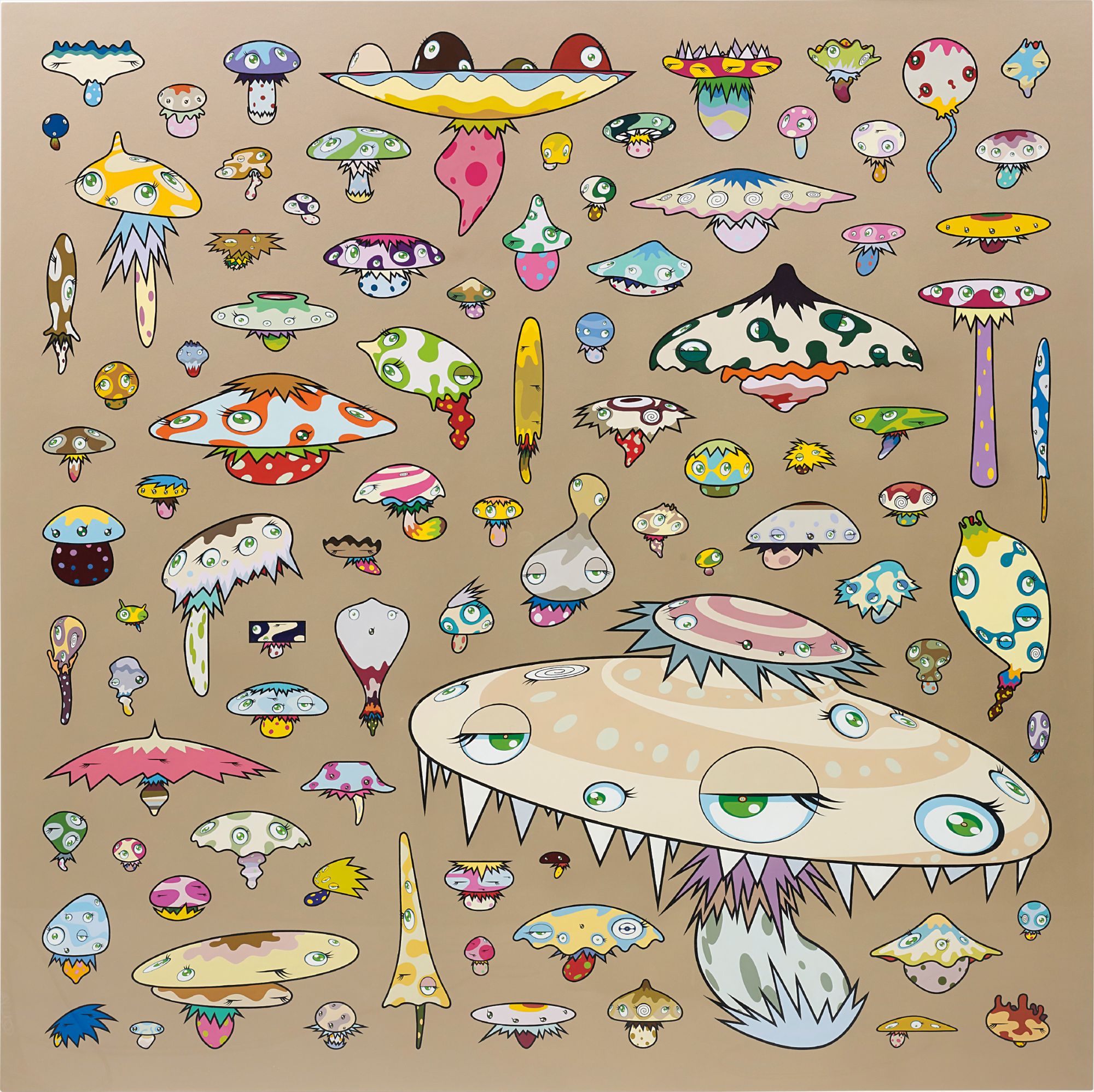

62Ο
Takashi Murakami
Army of Mushrooms
Full-Cataloguing
There is no artist quite like Murakami: the writer, director, painter, curator, sculptor, designer, animator and businessman has successfully turned his superflat aesthetic into a globally celebrated and recognized brand. After gaining a doctorate in Nihonga, a distinctly Japanese style of painting that is made in accordance with traditional Japanese conventions, techniques and materials, Murakami, an avid follower of manga, became interested in depicting postwar Japanese culture through incredibly refined pop iconography. Traumatized and infantilized, the collective psyche of postwar Japan grasped onto kawaii imagery in an obsessive draw to all things cute. Viewing kawaii as both attractive and repulsive, Murakami incorporated its language into his aesthetic as a way to explore what it says about Japanese contemporary culture and history. Murakami took a commercial approach to his aesthetic through pop sensibilities as a way to emphasize the shallowness of consumer culture. In this sense Murakami’s entire oeuvre explores the ways in which mass-produced entertainment and consumerism function within the tradition of fine art and essentially blurs the traditional lines between art, commerce, and pop culture.
In the case of the present lot, it is not only the mushroom motif that conjoins historical periods, but also the style in which they are rendered. In Army of Mushrooms, the titular fungi are drawn with bold outlines, grounded squarely in two dimensions. They belong to a longstanding dimensional tradition within Japanese aesthetics, as articulated by Murakami in his theory of the Superflat. They refer not only to a particular moment in the early twenty first century, but also to an enduring national tradition. Nonetheless, it is the influence of anime stylistics that is felt most acutely. A kawaii sensibility suffuses the piece; in their clean lines and light colors, the anthropomorphic fungi draw heavily upon the kitsch aesthetic. Meanwhile, the composition of the piece recalls a neatly arranged set: a panoply of variegated characters. The connotations are of collectability: a notion which is itself central to the fan-culture surrounding both anime and manga.
Given his interest in intersections and points of coalescence, the mushroom is an ideal motif for Murakami. The spore-laden fungus has a long history in Japanese culture, and is heavy with associative weight. Although part of the iconography of anime, the history of the mushroom in Japanese visual culture predates these contemporary forms. Peter Daszak and Sara E. Howard observe that “the mushroom ‘[appears] repeatedly in traditional Japanese art’ (Peter Daszak and Sara E. Howard, ‘Fungal Foray’, Eco Health 9, 2012, p.103), citing Ito Jakuchu’s eighteenth Century screens and Yumeji Takehisa‘s early twentieth century textiles by way of example. It is a subject, or symbol, in which the contemporary and the historical collide, and which traces a lineage through ‘high’ and ‘low’ art.
Alongside these quaint associations sit rather more mature concerns. The largest mushroom’s eyes droop as though in a daze, intimating the fungus’ link to hallucinogenic power. Indeed the palette and design of the piece, its vivid pools of color, playfully hint at the mushroom’s place in the tradition of psychedelia. Murakami himself suggests a further dimension to the work; “for me [mushrooms] seem both erotic and cute while evoking – especially for the Western imagination – the fantastic world of fairy tale” (Takashi Murakami as quoted in “Takashi Murakami”, Initial Access). Returning to the largest mushroom, one notices the batting eyelids. The gesture of seduction seems troublingly incongruous, and the world which the piece bodies forth is one of uneasy allure.
Disillusioned with the politics surrounding the Nihonga community, Murakami, who as a child dreamed of becoming an animator, looked to the niche, mass produced subcultural landscape of anime. Through an approach that combined his classical training with the distopic and kawaii, language of popular animation, Murakami developed the theory and aforementioned style Superflat. Seeking to differentiate itself from hegemonic Western traditions of painting and culture, Superflat places emphasis on Japanese legacy that embraces the two dimensional through flat glossy surfaces comprised of flat planes of color. Murakami developed Superflat in response to the way in which pop culture, graphic design and fine art had been ‘flattened’ in order to erase the lines between high and low culture.
Murakami is interested in notions of simultaneity and polyvalence. In his work, the contemporary gives way to the historical and the “low” cultural to the “high”. The mushroom is a motif which embodies these relationships. It is an image that runs throughout Japanese art, reappearing in a range of forms and media. Army of Mushrooms draws upon this historic multiplicity, but also bodies forth Murakami’s own unique vision. There is an undoubted exuberance to the piece: the colors are gaudy, and the finish glossy. Latent in the work, however, is a more ominous and illicit world into which the anthropomorphized fungi invite the viewer. As is so often the case in his work, Murakami gathers from popular culture to create a piece that is at once historically informed and individually-minded.
Takashi Murakami
Japanese | 1962Takashi Murakami is best known for his contemporary combination of fine art and pop culture. He uses recognizable iconography like Mickey Mouse and cartoonish flowers and infuses it with Japanese culture. The result is a boldly colorful body of work that takes the shape of paintings, sculptures and animations.
In the 1990s, Murakami founded the Superflat movement in an attempt to expose the "shallow emptiness of Japanese consumer culture." The artist plays on the familiar aesthetic of mangas, Japanese-language comics, to render works that appear democratic and accessible, all the while denouncing the universality and unspecificity of consumer goods. True to form, Murakami has done collaborations with numerous brands and celebrities including Kanye West, Louis Vuitton, Pharrell Williams and Google.